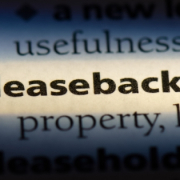Sale-Leaseback Is Quickest Path to Debt Restructuring, Panel Says
Sale-leaseback deals are offering property owners a stable, long-term solution to restructuring their debt when the lending window for refinancing mortgages has been slammed shut.
Increasingly, sellers are flocking to long-term net lease deals as the first step to cure their balance sheets, using the proceeds from the sale-leaseback to jump-start their debt restructuring, according to a panel of experts at the GlobeSt. Net Lease Spring 2023 conference in NYC this week.
“Sale-leasebacks are uniquely positioned to recapitalize existing mortgage yields,” said Bryan Huber, director of SAB Capital’s Sale-Leaseback Group.
For companies that still want to do deals but find the current cost of debt prohibitive, sale-leasebacks offer a less expensive, alternative form of borrowing that can close faster, the experts said. Sale-leasebacks deals also don’t require back-end balloon payments that often come with traditional financing.
Ross Prindle, global head of Kroll’s Real Estate Advisory Group, said buyers are using their resources, including financing and cash deals, to make sale-leaseback transactions more attractive to sellers by making it less expensive to execute the deals.
“The winners will be [the buyers] who do the best underwriting,” Prindle said.
“Eight is the new six in cap rates,” said David Grazioli, president of US Realty Advisors. “The cost to capitalize these rates is making a 20-year deal with 3% bumps look a lot better.”
According to Grazioli, an increasing number of sellers are opting for sale-leaseback deals because they have an urgent need to rehabilitate their cash flow and can’t wait for cap rates to compress again.
However, several experts on our panel warned that buyers must take care to make sure sellers actually are creditworthy before they ink sale-leaseback deals, which are extending to terms as long as 25 years in the current environment.
During Tuesday morning’s State of the Industry roundup session, Gary Baumann, CEO of NJ-based ARCTRUST Properties said the current credit climate is creating opportunities for sale-leaseback transactions.
“Where the credit climate is creating an advantage for all of us now is that it’s opening the window for the sale-leaseback market, larger than it’s been for a long time,” Baumann said. “Because of what’s happening with the banks, we’re seeing opportunities to acquire net leases that weren’t there before.”
On the opening night of our annual Spring Net Lease conference, W. P. Carey announced the largest sale-leaseback transaction in the NYC-based company’s 50-year history, a $468M sale-leaseback of a portfolio of four pharmaceutical R&D and manufacturing campuses in the Greater Toronto Area (GTA).
The portfolio represents the lion’s share of the global operations of Apotex Pharmaceutical Holdings, the largest generic drug manufacturer in Canada.
“This deal would have been a lot tougher to do when there were $200m to $300M CMBS deals available that could close simultaneously,” Gino Sabatini, head of investments at W.P. Carey, said during our sale-leaseback panel discussion.
According to Zachary Pasanen, managing director, investments at W. P. Carey, sellers are flocking to sale-leaseback for a less-expensive cost of capital and extra liquidity during tough times. A sale-leaseback offers a “naturally accretive” alternative funding source, Pasanen told GlobeSt. last month.
Holders of fungible, mission-critical real estate that are willing to sign a long-term lease with market or better rental increases built in can establish an underlying rate that lets them monetize those assets and is inside the going long-term borrowing rate, Pasanen said.
Source: GlobeSt.








